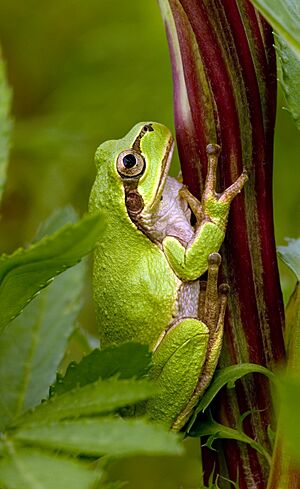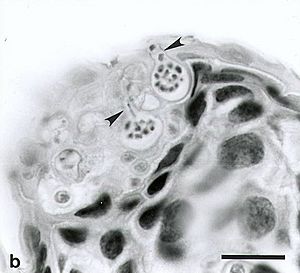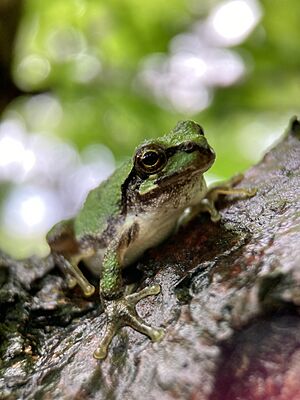Japanese tree frog facts for kids
Quick facts for kids Japanese tree frog |
|
|---|---|
 |
|
| Hyla japonica resting on a plant. | |
| Conservation status | |
| Scientific classification | |
| Synonyms | |
|
The Hyla japonica, often called the Japanese tree frog, is a type of frog found in Japan, China, and Korea. These amazing frogs can handle very cold weather. Some can even survive temperatures as low as −30 °C for up to 120 days!
Scientists don't think Japanese tree frogs are in danger of disappearing. The IUCN lists them as a species of "least concern." Interestingly, some of these frogs have even traveled to space! Scientists studied how they acted in microgravity, which is like being weightless. The scientific name Hyla japonica is also known as Dryophytes japonicus.
Japanese tree frogs live in many places, like wetlands, forests, rivers, and mountains. They usually stay near plants close to water and in forests. They are carnivores, meaning they eat other animals, mostly insects and spiders. A female frog can lay between 340 and 1,500 eggs at once. These frogs usually live for about six years.
Contents
What is a Japanese Tree Frog?
Japanese tree frogs are usually about 3.3 cm (1.3 inches) long. Their heads are about 1.2 cm (0.5 inches) wide and 0.9 cm (0.4 inches) long. The top part of their body is green or brown, and their belly is white. They also have a dark spot on their upper lip, right under their eye.
Female Japanese tree frogs are generally bigger than the males. Males have a dark vocal sac, which is a pouch under their chin that inflates when they call.
Unusual Colors
Sometimes, Japanese tree frogs have strange colors. In South Korea, some frogs were seen that were completely blue or yellow with green patterns. Another blue frog was found in Russia. When scientists observed it, it eventually turned back to its normal green-brown color. Scientists are still trying to figure out why these color changes happen. They think it might be due to genetic changes or problems adapting to their environment.
Where Do They Live?
Japanese tree frogs live in many parts of Asia. You can find them in Japan, China, Korea, Mongolia, and Russia. They like living in forests, bushy areas, meadows, swamps, and river valleys.
Like most frogs, they need both water and land to survive. This is because frogs lay their eggs in water, and their young (tadpoles) live in water before they grow into adult frogs that can live on land.
Sometimes, these frogs make their homes in rice paddies. These are flooded fields where rice is grown. Japanese tree frogs seem to do well in rice paddies. They especially like areas with lots of plants.
How Do They Act?
Scientists have studied how Japanese tree frogs behave in space, specifically in microgravity. When they were weightless, the frogs would bend their necks backward. They also walked backward, which is something sick frogs sometimes do. These actions might mean the frogs were feeling motion sickness.
However, the frogs learned to adapt to microgravity over time. They got better at jumping and perching. They also tried to eat but had trouble swallowing food. All the frogs sent to space returned safely. They went back to normal after about 2.5 hours on Earth.
What Do They Eat?
Japanese tree frogs hunt for food during both breeding and non-breeding seasons. They are "opportunistic predators," meaning they eat whatever food is easiest to find in their environment.
Their favorite food is ants. After ants, they often eat beetles and caterpillars. Male and female frogs seem to eat the same kinds of food. However, during the breeding season, male frogs might have empty stomachs more often. This is because breeding takes a lot of energy, so they might not eat as much.
Reproduction and Mating
Mating Habits
Male Japanese tree frogs gather in special areas called "leks" to find mates. A lek is a place where males meet to show off and try to attract females. These male gathering spots often form near good water sources. Females tend to go to these lek sites.
Scientists found that the places with the most male frogs were also the places where females were most likely to be found. This suggests that males choose lek spots where they are more likely to meet females. Females need water to lay their eggs, so males choosing spots near water helps them find females.
Frog Calls
Male Japanese tree frogs make calls to let females know they are there and to compete with other males. Their calls are made of short pulses and are mostly at a frequency of 1.7 kHz. They usually call at night, especially when they are on the banks of rice paddies. When the temperature goes up, male frogs make shorter calls and have shorter breaks between calls.
Where They Lay Eggs
Japanese tree frogs prefer to breed in shallow and smaller bodies of water. They especially like oxbow lakes. These are U-shaped lakes that form when a river bend is cut off. Frogs like them because they are still and have a good chance of being refilled with water. Tadpoles can't swim well in strong currents, so still water is better for them.
How Infections Affect Calling
Japanese tree frogs can get infected by a fungus called Batrachochytrium dendrobatidis. This fungus causes a disease called Chytridiomycosis. This disease has harmed many frog populations around the world.
While Japanese tree frogs can get Chytridiomycosis, it doesn't seem to make them very sick or cause many deaths. In Korea, about 10% to 16% of Japanese tree frogs have this infection.
However, Chytridiomycosis does change how male frogs call. Infected frogs make calls with more pulses and longer notes than healthy frogs. Scientists have two ideas why this happens. One idea is that the fungus makes the frogs try to reproduce more to help the fungus spread. Another idea is that the frogs try to reproduce more because they might die sooner from the disease. This way, they can pass on their genes before it's too late.
Mating with Other Species
Japanese tree frogs have sometimes been seen trying to mate with another frog species called Pelophylax chosenicus. Both species live in rice paddies, which might explain why they meet. Sometimes, when different but related species mate, they can create hybrid offspring. Scientists are still studying how often this happens between these two frog species.
Dangers to Japanese Tree Frogs
American Bullfrog Predators
The American bullfrog (Lithobates catesbeianus) is a non-native predator that eats Japanese tree frogs. When American bullfrogs hunt Japanese tree frogs, it can make the tree frogs' bones less dense. Bone density can show how much food an animal is getting. So, this means that American bullfrogs eating Japanese tree frogs can lead to the tree frogs getting less food. However, American bullfrog predation doesn't seem to change the physical shape of the Japanese tree frogs.
Amazing Frog Abilities
Skin Toxins for Defense
Japanese tree frogs have a special way to protect themselves from predators. They live in trees, and to avoid being eaten, they produce special toxins from their skin. These toxins are called Anntoxin-like neurotoxins. They are small proteins that can harm or even kill predators if they eat the frog's skin. This helps keep predators from hunting these frogs.
Surviving Extreme Cold
Japanese tree frogs have an incredible ability to survive very cold temperatures. They can live in temperatures as low as −35 °C. Many frogs from the Amur River area can survive being exposed to −30 °C multiple times. Some can even survive at −30 °C for up to 120 days! Other frog species would freeze and die at these temperatures, but Japanese tree frogs don't form ice inside their bodies.
When it gets cold, Japanese tree frogs produce a substance called glycerol. They make more glycerol as the temperature drops. Scientists think glycerol helps them resist the cold. However, other frog species also produce glycerol but can't handle the cold as well. So, scientists are still trying to fully understand how Japanese tree frogs survive such extreme cold.
Bone Health Studies
Scientists have also studied the bone density of Japanese tree frogs. They wanted to see if bone density could tell them about a frog's overall health. They found that frogs with broken bones did not have much different bone density than healthy frogs. This means their broken bones were likely from injuries, not from bone diseases.
Bone density was closely related to the frog's length. Male and female frogs had similar bone densities, probably because they eat similar foods. Frogs were found to have fractures equally in their front and back legs.
Studying bone density helped scientists understand how well-fed and healthy frog populations are. This can be a useful tool for checking on frog groups.
Protecting the Japanese Tree Frog
The IUCN says that the Japanese tree frog is a "Least Concern" species. This means they are not currently in danger of extinction. Their population is stable and spread out.
However, the IUCN does list some possible threats. Pollution and other environmental factors are concerns. For example, climate change might cause more droughts, which would harm the frogs' habitats since they need water to survive. Also, more farming and land for livestock could take away some of their homes.
Luckily, Japanese tree frogs can live in many different places, including rice paddies, cities, and mountains. This ability to adapt means these changes might not affect them too much.
Japanese tree frog tadpoles can also get a virus called ranavirus. This virus spreads through contact between animals. It can cause swelling, bleeding under the skin, and damage to organs like the liver, kidney, and spleen. Changes in climate and habitat can make the virus spread more easily. Ranavirus can infect many cold-blooded animals, including other amphibians and fish.
How Frogs Help Humans
Male Japanese tree frogs are very good at spacing out their calls. They avoid calling at the exact same time as other males. This helps females hear each male's call clearly. If many males call at once, females can't tell where each male is, which makes mating difficult. Japanese tree frogs can do this without a central leader or much communication.
Humans have studied this amazing ability. We use what we learn from these frogs to design wireless communication networks. This helps make networks more efficient, especially when there isn't a main control center. This field of study is called "swarm intelligence," and scientists are still learning more about it.
|






